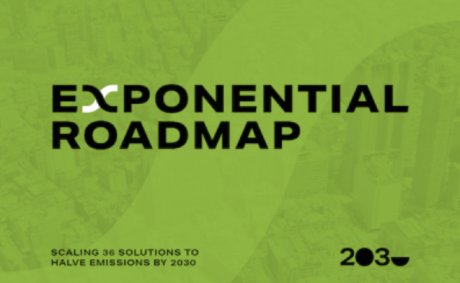Exponential Roadmap
Solutions on how to halve the emissions by 50% until 2030 by the Exponential Roadmap.
From Exponetial Roadmaps homepage; “The Exponential Roadmap highlights the 36 solutions that can scale exponentially to halve Greenhouse Gas Emissions by 2030 worldwide. Scaling of solutions comes from sharp policy, from climate leadership by companies and cities and from a finance and technology shift towards green solutions with exponential potential. The roadmap shows how we can build a stronger, more resilient and future-proof global economy and increase human prosperity and health – within the planetary boundaries.”
Here is my summary from the part about the industry sector;
The industrial sector is responsible for 17 Gt CO2e annually, which represents 32% of the global total. (Johan Falk et al. 2019) This figure can be split into two parts.
1. Energy- intensive heavy industries which include materials manufacturing that represent substaintial emissions: steel, cement, plastics, aluminium and chemicals.
2. Less energy-intensive light industry, such as fashion, furniture and home appliances.
The furniture industry is the less energy-intensive part, for furniture the material choice stands for about 50% of the total emissions.
Halving the emission by 2030
The Exponential Roadmap initiative latest report has put together 36 solutions on how to cut greenhouse gas emissions 50% by 2030. The key solutions in the industry sector to reduce supply-side emissions revolve around a few key principles.
1. Materials recirculation ca 20%
2. Product material efficiency ca 5%
3. Production efficiency ca 10%
4. Circular business models ca 5%
5. Refrigerant management can10%
Recirculating materials, ca 40%
Re-using material which already has been produced is a key opportunity to reduce emissions. The amount of reclaimable material in the world is steadily growing, and energy savings range from 60–75% for using recycled, rather than new steel. The savings for steel are up to 90%.(5) Achieving these savings requires that products be designed specifically for disassembly and recycling, that material contamination is avoided and that material collection rates and processes are improved.
Making products with less materials, ca 2,5% (av5%)
Wealthy nations frequently use more materials than necessary – for example, EU countries use an average of 800 kg of steel, concrete, aluminum and chemicals per person per year.(7,8,9) By reducing the amount of materials used, or increasing their usable lifetime, costs can be lowered at the same time as emissions are reduced.
Replacing high-carbon materials with low-carbon ones, ca 2,5% (av5%)
2016 I did an exhibition during at the Swedish Furniture Fair called; Where does it come from, where does it go? In the exhibition we focused on materials. Materials who I usually work with at the studio. How, and to what degree, does different materials have an impact on climate change? Is it possible to rank different materials in terms of their level of sustainability? The exhibition was an attempt to provoke the importance of how different materials impact climate change and to what extent. With the help from IVL, the Swedish Environmental Institute I took a shot at precisely that. This was not an easy task. Therefore, we focused solely on how different materials differ in CO2e- footprint.
Optimizing production processes and 10%
The energy intensity of this sector could be reduced by up to 25% by 2030 by upgrading or replacing existing equipment with the best available on the market. The adoption of renewable electricity and heating/cooling will provide further cuts. Additional reductions of up to 20% of annual energy intensity are possible by measuring processes and energy use in real time and using artificial intelligence techniques to continually optimize them.(10)
Enabling a circular economy. 5%
A more circular economy could cut cumulative emissions from heavy industry by 56% by 2050 in the EU, and 45% of cumulative emissions from the steel, cement, plastic and aluminium products globally.(11) Additionally, service-based business models, where buildings, tools and vehicles which sit idle for 90% of the time are unlocked for others to use, are another huge opportunity to boost profits and reduce emissions simultaneously.

